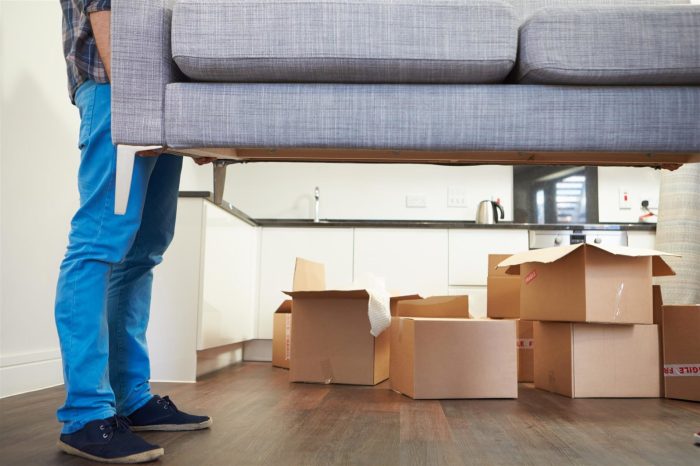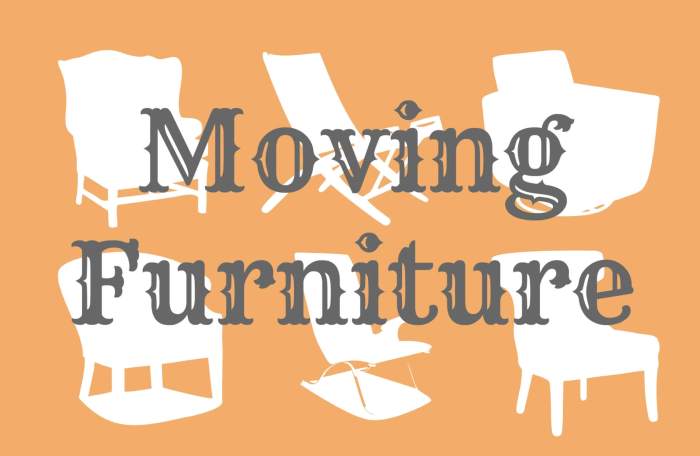Moving furniture is an inevitable part of life, whether it’s for a new home, office, or simply a change of scenery. But it doesn’t have to be a daunting task. With the right techniques, tools, and planning, you can make your move a breeze.
In this comprehensive guide, we’ll cover everything you need to know about moving furniture, from disassembly and packing to loading and unloading, ensuring a smooth and stress-free relocation.
Furniture Moving Methods

Moving furniture can be a daunting task, but it can be made easier by using the right methods and taking the necessary precautions. There are several different ways to move furniture, each with its own advantages and disadvantages.
Manual Lifting
Manual lifting is the most basic method of moving furniture. It is also the most physically demanding, so it is important to use proper lifting techniques to avoid injury. To manually lift furniture, stand close to the object and bend your knees, keeping your back straight.
Grip the object with both hands and lift it straight up, using your legs to do the work. Do not twist your body while lifting, and be sure to get help if the object is too heavy.
Dollies
Dollies are wheeled platforms that can be used to move heavy objects. They are available in a variety of sizes and shapes, so it is important to choose one that is appropriate for the size and weight of the furniture you are moving.
Moving furniture can be a daunting task, but it doesn’t have to be. By partnering with reputable furniture shipping companies , you can ensure your furniture is transported safely and efficiently. These companies specialize in handling delicate items and can provide peace of mind during the moving process.
To use a dolly, place it under the furniture and lift the object onto the platform. Secure the object to the dolly with straps or ropes, and then roll it to its new location.
Moving furniture can be a daunting task, especially when you have heavy or bulky items. If you’re looking for a solution that makes the process easier, consider investing in matrix furniture . Matrix furniture is designed with modular components that can be easily disassembled and reassembled, making it ideal for moving.
Plus, its durable construction ensures that your furniture will withstand the rigors of transport and reassembly.
Sliders
Sliders are thin, flat pads that can be placed under furniture to make it easier to slide across the floor. They are available in a variety of materials, including plastic, felt, and rubber. To use sliders, place them under the legs of the furniture and then push or pull the object to its new location.
Straps
Straps can be used to lift and move heavy furniture. They are typically made of nylon or polyester and are available in a variety of lengths and widths. To use straps, wrap them around the object and then lift it using the handles.
Be sure to get help if the object is too heavy.
Furniture Disassembly and Assembly

Furniture disassembly and assembly are crucial for a seamless and efficient moving process. Disassembling bulky furniture not only reduces its size and weight, making it easier to transport through narrow spaces and doorways, but also helps prevent damage during transit.
Common Furniture Types and Disassembly/Assembly Processes
Different furniture types require specific disassembly and assembly techniques. Here’s a guide to common furniture pieces and their processes:
- Tables:Most tables have removable legs that can be unscrewed or detached using an Allen key. For tables with intricate bases, consult the manufacturer’s instructions.
- Chairs:Disassemble chairs by removing the cushions, then unscrewing the legs or backrest from the seat.
- Beds:Detach the headboard and footboard from the side rails. Remove the slats or box spring and disassemble the frame.
- Sofas:Sectional sofas can be disassembled by unzipping the cushions and removing the connecting brackets. For non-sectional sofas, consult the manufacturer’s instructions.
- Cabinets:Remove the doors and drawers. For tall cabinets, disassemble the shelves and drawers.
Handling Fragile Pieces
When handling fragile pieces, it’s essential to wrap them securely with bubble wrap or blankets. Use masking tape to secure the wrapping and prevent it from slipping. Handle fragile items with care and avoid placing heavy objects on top of them during transport.
Ensuring Proper Reassembly
Before disassembling furniture, take photos or videos of the process to serve as a reference during reassembly. Label the disassembled parts and keep them organized to avoid confusion. Use the manufacturer’s instructions or online tutorials for proper reassembly.
Packing and Protection
Proper packing is crucial during furniture moving to prevent damage during transport. It ensures that your belongings arrive at their destination in the same condition they left.
Packing materials serve various purposes and should be chosen accordingly. For example, bubble wrap provides cushioning for delicate items, while padding protects surfaces from scratches and dents. Shrink wrap secures items together, preventing them from shifting during transit.
Packing Materials
- Bubble Wrap:Provides cushioning and protection for fragile items like glassware and electronics.
- Packing Paper:Used to wrap and fill empty spaces, preventing items from moving around.
- Padding:Foam or cardboard sheets used to protect surfaces from scratches and dents.
- Shrink Wrap:Plastic film used to secure items together, preventing them from shifting during transit.
- Carton Boxes:Sturdy boxes used to pack heavier items and protect them from damage.
Protecting Delicate Surfaces
Delicate surfaces, such as glass tabletops and mirrors, require special protection during transport. Bubble wrap, padding, and shrink wrap can be used in combination to provide multiple layers of protection.
Bubble Wrap:Wrap the surface generously, ensuring there are no gaps.
Padding:Place padding over the bubble wrap to protect against impacts.
Moving furniture can be a hassle, but it doesn’t have to be. If you’re looking for high-quality furniture in Indianapolis, consider Havertys Furniture . They offer a wide selection of styles to choose from, and their experienced staff can help you find the perfect pieces for your home.
Plus, they offer delivery and assembly services, so you can relax and enjoy your new furniture without any of the hassle.
Shrink Wrap:Secure the padding and bubble wrap in place, creating a tight and protective barrier.
Loading and Unloading
Loading and unloading furniture is a crucial part of the moving process, requiring careful planning and execution to ensure safety and minimize damage to your belongings. Here’s a comprehensive guide to different loading and unloading techniques, along with tips for maximizing space and securing furniture during transport.
Loading Techniques
- Ramps:Ramps provide an inclined surface to roll heavy furniture into moving vehicles, reducing the risk of back strain and injury. Choose ramps with a sturdy construction and an appropriate weight capacity for your furniture.
- Lifts:Furniture lifts are powered platforms that elevate heavy items to the level of the moving vehicle. This method is particularly useful for bulky items that cannot be easily lifted manually.
- Hoists:Hoists are motorized devices that lift and lower furniture through windows or over balconies. They are ideal for moving large or heavy items to upper floors or into tight spaces.
Maximizing Space
To maximize space in the moving vehicle, utilize the following techniques:
- Disassemble furniture whenever possible to reduce its volume.
- Pack smaller items inside larger pieces to save space.
- Stack boxes and furniture vertically to utilize vertical space.
- Use blankets and padding to fill empty spaces and prevent items from shifting.
Securing Furniture
To secure furniture during transport, follow these tips:
- Use straps or bungee cords to secure furniture to the walls or floor of the moving vehicle.
- Place heavy items on the bottom and lighter items on top to prevent crushing.
- Wrap fragile items in protective materials and label them clearly.
- Avoid placing heavy items on top of upholstered furniture to prevent damage.
Unloading Techniques
When unloading furniture, follow these steps to minimize the risk of damage:
- Unload heavy items first, using the same techniques used for loading.
- Carry furniture carefully and avoid dragging it across the floor.
- Place furniture in its designated location and inspect it for any damage.
- Unpack and assemble furniture as soon as possible to prevent damage from prolonged storage.
Furniture Placement
Furniture placement is a crucial aspect of moving as it determines the functionality, comfort, and overall aesthetics of your new space. Planning ahead can save you time, effort, and the hassle of rearranging furniture multiple times.
When arranging furniture, consider the following guidelines:
Living Room
- Arrange seating around a focal point, such as a fireplace, TV, or artwork.
- Leave ample space for traffic flow and avoid blocking walkways.
- Use larger pieces to define the room’s layout and create a sense of balance.
Bedroom
- Place the bed as the focal point of the room, centered or against a wall.
- Arrange nightstands on either side of the bed for convenience and symmetry.
- Utilize vertical space with shelves and wall-mounted storage to maximize space.
Kitchen
- Create a “work triangle” between the sink, refrigerator, and stove for efficient cooking.
- Use islands or peninsulas to extend counter space and provide additional storage.
- Consider the placement of appliances to minimize noise and maximize ventilation.
Home Office, Moving furniture
- Position the desk facing a window for natural light and inspiration.
- Ensure there’s ample space for storage, filing cabinets, and other office equipment.
- Create a designated area for breaks or relaxation to maintain focus and productivity.
Additional Tips
- Use furniture to create focal points and define areas, such as a reading nook or a home theater.
- Experiment with different arrangements until you find one that suits your needs and preferences.
- Consider the size and shape of the room, as well as the amount of natural light available, when planning furniture placement.
Ending Remarks

Moving furniture can be a challenging but rewarding experience. By following the tips and techniques Artikeld in this guide, you can minimize the hassle and maximize the efficiency of your move. Remember to plan ahead, disassemble furniture when possible, pack items securely, and load and unload carefully.
With proper preparation and execution, you can ensure that your furniture arrives at its new destination safely and in pristine condition.
FAQ Summary: Moving Furniture
What is the best way to move heavy furniture?
Use furniture sliders or dollies to move heavy furniture easily and protect your floors.
How do I disassemble furniture for moving?
Follow the manufacturer’s instructions or use a screwdriver to remove screws and bolts. Label all parts for easy reassembly.
What is the best way to pack furniture for moving?
Use bubble wrap, packing paper, and blankets to protect furniture surfaces. Secure items with packing tape and label boxes clearly.
How do I load furniture into a moving truck?
Use ramps or a lift to load heavy furniture. Secure items with straps or bungee cords to prevent shifting during transport.